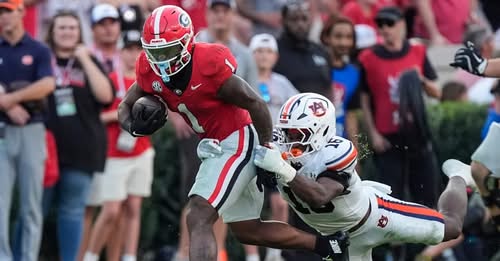The Auburn football program is entering the 2025 season with a linebacker corps that looks nearly unrecognizable compared to previous years. After losing four seniors who were key contributors at linebacker over the offseason, the Tigers face a significant transition period at one of the most critical and demanding positions on the field. This shift in personnel not only challenges Auburn’s defensive depth but also presents an opportunity for younger players and newcomers to step up and define the identity of the linebacker unit moving forward.
The departure of four senior linebackers is a major change for any college football team, especially one like Auburn, which has historically placed great emphasis on physicality and athleticism in its defensive front seven. These seniors were more than just bodies on the roster; they brought leadership, experience, and a deep understanding of the defensive scheme. Losing that kind of presence means the Tigers must rebuild their linebacker corps with a combination of returning underclassmen, incoming recruits, and potential transfers who can quickly adapt to the fast pace and physical demands of SEC football.
One of the biggest challenges for Auburn will be maintaining continuity and stability within the linebacker room. The senior linebackers who graduated were likely the ones calling defensive adjustments on the field, reading offenses, and setting the tone with their intensity and discipline. Their experience in game situations allowed them to anticipate plays and execute assignments effectively, which often makes the difference in close games. Without their steady presence, the younger players will have to grow up quickly, develop chemistry with the defensive unit, and learn to communicate efficiently on the field. The coaching staff will play a crucial role in accelerating this learning curve, ensuring the new linebackers understand not only their individual roles but also the overall defensive philosophy.
The good news for Auburn is that they are not starting from scratch. While the loss of four seniors is significant, the program still retains some promising linebackers who saw limited action in previous seasons or have been waiting in the wings to claim a more prominent role. These players have likely been gaining valuable experience in practice, learning the system, and physically developing to compete at the highest level. This offseason will be their chance to shine and prove they belong as key contributors. Their progression will be pivotal to the Tigers’ defensive success in 2025.
Additionally, the Auburn coaching staff has been active in recruiting and building depth at linebacker. Over the past few years, the Tigers have brought in several highly touted linebackers through the recruiting process, many of whom were rated as four- or five-star prospects. These recruits often arrive with the athletic ability, size, and speed necessary to make an impact at the college level, but the transition to the SEC requires more than just raw talent. Learning to read complex offenses, understanding multiple defensive fronts, and executing assignments under pressure are critical aspects that Auburn’s coaches will emphasize during spring and fall camp. The infusion of fresh talent, combined with returning players eager to prove themselves, creates an intriguing mix that could revitalize the linebacker corps.
Another factor to consider is Auburn’s potential use of transfers. The transfer portal has become a major aspect of college football roster management, allowing teams to address immediate needs quickly. It would not be surprising to see Auburn target experienced linebackers through this avenue, especially given the sudden loss of so many seniors. Transfers bring not only talent but also college game experience, which can help bridge the gap while younger players develop. However, integrating transfers seamlessly into the team’s culture and scheme remains a challenge, and the coaching staff will need to ensure these players fit Auburn’s style and values.
Physically, the new linebacker group will need to adjust to the rigorous demands of SEC football, which is known for its speed, power, and physicality. The Tigers have always prided themselves on tough, aggressive linebackers who can stop the run, cover tight ends and running backs in pass coverage, and blitz effectively when called upon. Training and conditioning programs will be tailored to ensure these new linebackers have the endurance, strength, and agility necessary to excel. The position requires a unique blend of skills, and the coaching staff’s ability to identify and develop these traits in the new players will determine how quickly Auburn’s linebacker corps can return to form.
The loss of seniors also means Auburn will likely have to adjust its defensive schemes and game plans to accommodate the strengths and weaknesses of the new linebackers. For example, if the incoming players are better in pass coverage than in run support, the defensive coordinator might call for more zone schemes or employ more safeties to help against the run. Conversely, if the new linebackers excel in rushing the passer, Auburn might increase blitz packages or aggressive stunts to disrupt opposing offenses. Flexibility in scheme and willingness to adapt to personnel changes are essential for the Tigers to remain competitive in a conference as tough as the SEC.
Leadership within the linebacker room will be another key focus area. The previous seniors likely carried the torch as vocal leaders, guiding younger teammates and setting a professional example on and off the field. With their departure, new leaders must emerge quickly to maintain team morale, focus, and discipline. Leadership development is often intangible but critical for a successful unit, especially one undergoing such transition. Coaches will be looking for players who not only perform well on the field but also demonstrate accountability, resilience, and a commitment to team culture.
From a strategic perspective, linebackers are the heart of the defense. They are responsible for reading the offense, making split-second decisions, and reacting swiftly to both run and pass plays. The Tigers’ ability to stop the run and limit explosive plays will largely depend on how well these new linebackers fill the gaps left behind. If they can establish dominance at the second level, Auburn’s defense can create turnovers, force three-and-outs, and put their offense in favorable field positions. Failure to do so could lead to vulnerabilities that opponents will eagerly exploit.
Moreover, Auburn’s special teams could also feel the impact of changes at linebacker. Linebackers often contribute heavily to kick coverage and return units, where speed and tackling ability are paramount. The new group will need to prove their value in these areas as well, which could influence the overall success of Auburn’s special teams units. This multifaceted role of linebackers highlights how critical it is for the new players to be versatile and well-rounded athletes.
While the transition is challenging, it also brings excitement and anticipation. Fans will be watching closely to see which players step up and how the coaching staff molds the linebacker group into a cohesive, formidable unit. The 2025 season could be a defining year for these new linebackers as they carve out their own legacies within Auburn football history. Success at this position can galvanize the entire defense, creating momentum that carries through the season and into future years.
In summary, Auburn’s linebacker corps for the 2025 season will be almost completely different due to the offseason loss of four senior players. This significant turnover demands a rapid development of younger talent, possible infusion of transfers, and strategic adjustments by the coaching staff. The linebackers must rise to the occasion, embracing leadership roles and mastering the physical and mental aspects required at the SEC level. While the road ahead is filled with challenges, it also offers a chance for new stars to emerge and for Auburn’s defense to renew its identity. How well the Tigers navigate this transition could shape their competitiveness and defensive prowess in the coming years, making the 2025 linebacker unit one of the most watched and analyzed groups in Auburn football’s recent history.



